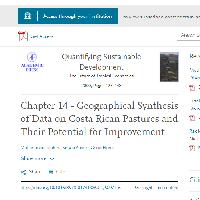Resumen
-
The intervention of humans in the ecosystems of Costa Rica was minimal before the Spanish conquest. In Central America, including Costa Rica, human pressure on the use of land for animal agricultural activities has increased greatly during recent decades, raising many questions pertaining to sustainability. Domesticated animals, particularly cattle, are often regarded as a destabilizing factor in land use and a major contributor to environmental degradation. Their role in reducing the sustainability of land centers on issues of overgrazing, deforestation, soil compaction, and competition with wildlife. This chapter focuses on the long-term viability of raising livestock as a sustainable income source for the Costa Rican economy. Any agricultural development requires a trade-off with preservation of undisturbed ecosystems, improved management of agriculturally productive areas, and rehabilitation of degraded lands. The objective of this chapter is to make an analysis of pasture evolution in Costa Rica, generate an estimate of what the potential yield is and in what ways yield is a function of various environmental and management characteristics, and examine quantitatively the degree to which activities associated with pastures do or do not contribute to the sustainability of the Costa Rican economy and environment.
